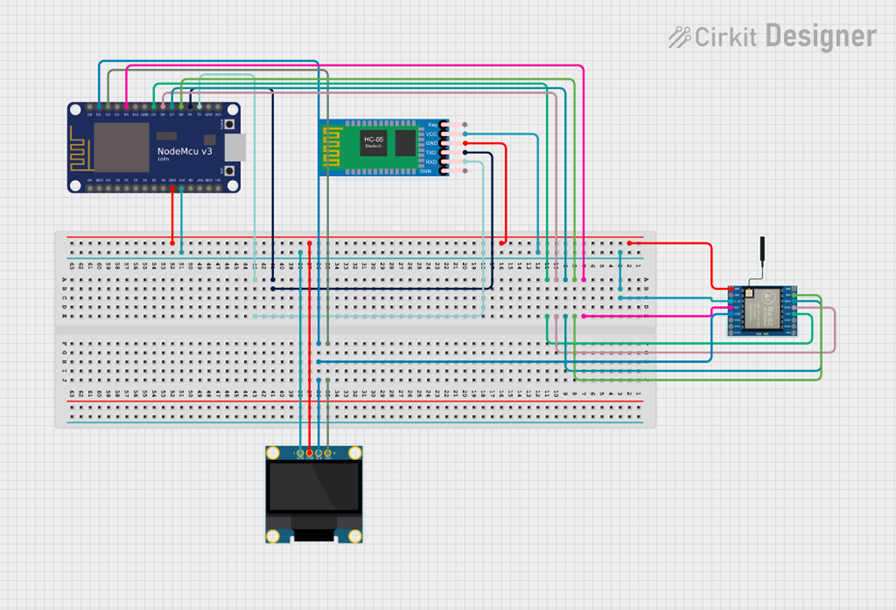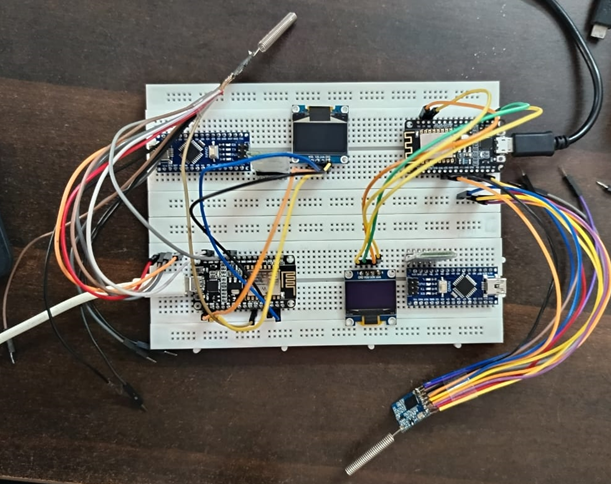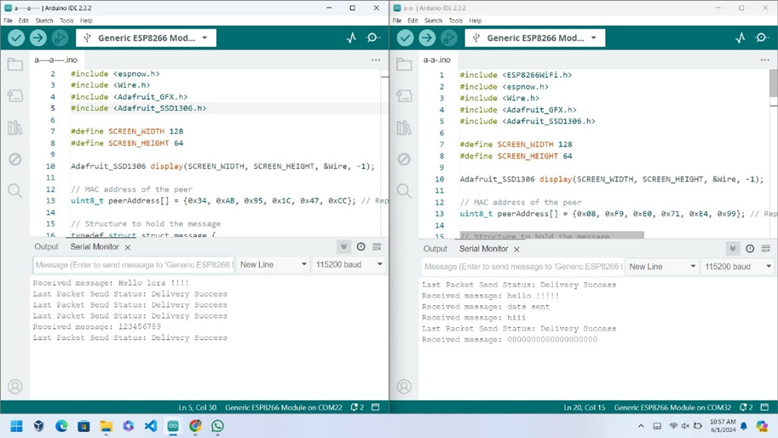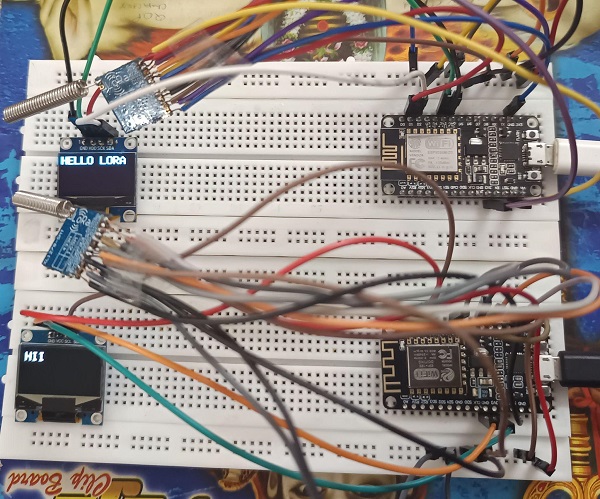Ijraset Journal For Research in Applied Science and Engineering Technology
- Home / Ijraset
- On This Page
- Abstract
- Introduction
- Conclusion
- References
- Copyright
GSM Less Communication Over Long-Range Using LoRa (SX1278) Module
Authors: K. Govardhani Gupta, S. Reethu Varma, P. Mounika, G. Swaptika, Lakshmi Narayana, P. N. S. Sri Vardhan, K. Jogi Naidu
DOI Link: https://doi.org/10.22214/ijraset.2025.66208
Certificate: View Certificate
Abstract
Communication is the key to establishing a connection between devices. The ability of devices to communicate with each other and provide required output according to user requirements is most important in today’s technology field. The most common communication is Zigbee, Wi-Fi, and others are short-range, and GSM is required. This leads to difficulties in deploying IoT solutions in areas without cellular (GPRS, EDGE,3G, LTE/4G) coverage and gross reduction in the battery life of devices. Thus, to provide better connection in all areas, we need low power, long range, and security to deploy. This is where LoRa comes in. LoRa (Long Range) is a wireless communication technology combining ultra-low power consumption with an effective long range. It ranges between 13-15 km which indicates that a single LoRa gateway can provide the entire coverage of the city, and with a couple of it, a whole country can be covered. This paper aims to provide you with the necessary knowledge to transmit messages across vast distances by utilizing Arduino boards, a duo of SX1278 LoRa Transceiver modules, a pair of HC05 or HC06 Bluetooth modules, and a pair of OLED screens.
Introduction
I. INTRODUCTION
LoRa, short for "long range," is a proprietary radio communication technology that allows for long-distance transmissions using minimal power.
LoRa, which was originally created by Cycleo and later acquired by Semtech, utilizes spread spectrum modulation techniques based on chirp spread spectrum (CSS) technology1. It operates within license-free sub-gigahertz radio frequency bands, including EU868 (Europe), AU915/AS923-1 (South America), US915 (North America), IN865 (India), and AS923 (Asia)1. With its remarkable capability, LoRa can achieve a range of over 10 kilometers (6.2 miles) under ideal conditions, making it an ideal choice for long-distance communication.
LoRa (https://lora-alliance.org) is one of the LPWAN protocols and the subject of study for this paper. LoRa targets deployments where end devices have limited energy (for example, battery-powered), where end devices do not need to transmit more than a few bytes at a time, and where data traffic can be initiated either by the end device (such as when the end-device is a sensor) or by an external entity wishing to communicate with the end-device (such as when the end-device is an actuator). The long-range and low-power nature of LoRa makes it an interesting candidate for smart sensing technology in civil infrastructures (such as health monitoring, smart metering, environment monitoring, etc.) and industrial applications.
Lora uses license-free radio frequency bands. The most widely used frequencies are:
- 868MHz in Europe
- 915MHz in Australia and North America
- 923MHz in Asia
ESP8266 LoRa communication over Long distance without GSM Network– In this paper, we will learn how to send messages over long distances using ESP8266 boards, a pair of SX1278 LoRa Transceiver modules, a pair of HC05 or HC06 Bluetooth modules .
With this paper, we have designed, where we don’t need the GSM network to send or receive free SMS or messages. We shall demonstrate the process of sending Free SMS using long-range LoRa transceiver modules.
If we are in a place where there is a GSM network then we can proceed to use our smartphone to send or receive our calls or messages. In such a scenario, there is no need of having any sort of reliance on a LoRa network for the purpose of conveying messages.
But just think about yourself in a completely different class of a situation for instance you and your friends or teammates are at a place in a remote or mountainous type of a region where the GSM network connection is not available anywhere, then how can it be possible to talk to your teammates or friends?
Well, there are only two approaches one can take regarding such a scenario.
- You can either use and carry around an expensive readymade walkie-talkie, portable two way transceivers to such a place along with you, which you cannot customize to your wish or not according to your requirement. These devices will simply be used for what they have been created to be used for, and nothing more.
- The second and the more practical and far more effective kind of option which can be applied is to rely on my specifically developed long-range wireless SMS/Text Messaging system that is capable of being altered based on the need or a situation as per one’s choice. You can even build a whole network from this system and as such, you can easily communicate with any member of your team quite
LoRa FEATURES AND SPECIFICATIONS
- Frequency range: 420–450 MHz or 433 MHz
- Modulation: FSK, GFSK, MSK, GMSK, LoRa, and OOK
- Sensitivity: -136 dBm to -148 dBm
- Output power: +20 dBm
- Data rate: Up to 300 kbps
- RSSI dynamic range: 127 dB
- Working temperature: -40°C to +85°C
- Operating voltage: 1.8–3.7 V, default 3.3 V
- Packet engine: Up to 256 bytes with CRC
II. SYSTEM ARCHITECTURE DESIGN
The system leverages LoRa (Long Range) technology to establish a GSM-less communication network, tailored for remote and rural applications. LoRa technology, characterized by its long-range communication capabilities and low power consumption, offers a compelling alternative to GSM networks. This section outlines the design and functionality of the proposed system, emphasizing its advantages over existing GSM-based solutions.
A. Design and Functionality
- LoRa Technology: Among other technologies, Long Range (LoRa) uses chirp spread spectrum modulation which makes the communication very effective with low power consumption over long distances. Wireless communication with the use of LoRa platform occurs in the unlicensed Industrial, Scientific, and Medical frequency bands offering affordable and scalable networks.
- NodeMCU (ESP8266) Microcontrollers: These microcontrollers play the role of system-on-chip interfaces integrating with LoRa integrated circuits to control data acquisition, transfer, and receipt. NodeMCU also has WiFi capability builtin to the device and also allows for open local network connection and internet access if needed.
- Network Architecture: This can be proved by the fact that it can still be implemented as a private network, and this offers more control and security than being in the public domain. This architecture carries no dependence on the GSM network infrastructural support hence lowering operational costs while at the same time increasing reliability especially in areas deemed unreachable by conventional GSM technologies.
- Sensor Integration: There are several sensors which are interfaced to the NodeMCU to monitor environmental conditions such as moisture, temperature and humidity and the LoRa network is used to send the information to a server or a base station.
B. Software Requirement
1) Development Environment
- Arduino IDE: It is used for programming the NodeMCU microcontrollers. The Arduino IDE, which is open source software, is used for the purpose of writing, compiling and uploading code to the Arduino microcontroller boards. It has a friendly user interface together with libraries and tools that facilitate MCU programming hence making it user-friendly for both beginners and experts.
- Library manager: It also possesses a library manager whereby users can download and manage different libraries such as those used to interface with sensors, modules, peripherals.
- Serial Monitor: This is a tool in Arduino IDE that allows the user to send data via serial port on PC to ARDUINO board. It enables sensor data real-time monitoring, debugging of codes as well as interaction with microcontrollers.
- Board Manager: There are a variety of boards supported by this board manager where users can select their type of Arduino board after configuring it properly.
2) Libraries and Frameworks
- Adafruit GFX Library: The Adafruit GFX Library is a collection of graphical functions that can be used to draw shapes, text and images on OLED displays.
- Adafruit SSD1306 Library: Adafruit SSD1306 Library is specifically created to manage SSD1306 driver chip based OLED displays. It initializes the display, draws graphics and updates display contents.
- LoRa Library: This LoRa library facilitates communication with LoRa modules such as SX1278 for long range wireless communication. It has functions for configuring Lora parameters, sending/receiving data packets and managing Lora communication
- ESP8266WiFi Library: In addition, ESP8266WiFi Library permits NodeMCU (ESP8266) microcontrollers to connect with WiFi networks and then communicate over int
C. Hardware Requirement
This circuit integrates various communication modules with a NodeMCU V3 ESP8266 microcontroller. The circuit features an OLED display for visual output, an HC-05 Bluetooth module for wireless communication, and a LoRa Ra-02 SX1278 module for long-range communication. The components are interconnected through a series of nets that establish power, ground, and signal connections. The NodeMCU serves as the central processing unit, interfacing with the other modules to facilitate data exchange and control.
- OLED 128x64 I2C Monochrome Display: The 0.96-inch OLED Display Module – SPI/I2C – 128×64 – 7 Pin (Blue) are one of the most attractive displays available for a microcontroller. OLED’s are the future of displays, as they possess some of the greatest advantages over both conventional display technologies of LCD’s and LED‘s. The most attractive thing about using the OLED displays is that they do not need a back-light like conventional LCD/LED screens. The organic material itself has a property known as Electroluminescence (EL), which causes the material to “glow” when stimulated by a current or an electric field.
- HC-05 Bluetooth Module: The HC-05 Bluetooth module is a widely used wireless communication device that allows for serial communication over Bluetooth.The HC-05 can operate in both master and slave modes, making it versatile for different use cases.
- LoRa Ra-02 SX1278: The SX1278 is a semtech’s highly integrated RF transceiver module, and it is designed to operate using LoRa (Long Range) modulation technology in low power wide area networks for long-range, low-power wireless communication.
- NodeMCU V3 ESP8266: The main component used in this project is ESP8266 NodeMCU which sends data to the web server through the internet. So, let’s see how this module works through the internet. NodeMCU is an open-source firmware for which open-source prototyping board designs are available.
III. CIRCUIT CONNECTION

Fig1 : Circuit Wiring
A. Wiring Details
OLED 128x64 I2C Monochrome Display
- VDD: Connected to the 3.3V net.
- GND: Connected to the ground net.
- SCK: Connected to NodeMCU pin D1.
- SDA: Connected to NodeMCU pin D2.
HC-05 Bluetooth Module
- Key: Not connected in this circuit.
- VCC: Connected to the 3.3V net.
- TXD: Connected to NodeMCU pin RX.
- RXD: Connected to NodeMCU pin TX.
- State: Not connected in this circuit.
LoRa Ra-02 SX1278
- NSS: Connected to NodeMCU pin D8.
- MOSI: Connected to NodeMCU pin D7.
- MISO: Connected to NodeMCU pin D6.
- SCK: Connected to NodeMCU pin D5.
- DIO5: Not connected in this circuit.
- DIO4: Not connected in this circuit.
- 3.3V: Connected to the 3.3V net.
- RST: Connected to NodeMCU pin D4.
- DIO0: Connected to OLED display pin SCK.
- DIO1: Not connected in this circuit.
- DIO2: Not connected in this circuit.
- DIO3: Not connected in this circuit.
NodeMCU V3 ESP8266
- GND: Connected to the ground net.
- 3V3: Connected to the 3.3V net.
- D1: Connected to OLED display pin SCK.
- D2: Connected to OLED display pin SDA.
- D4: Connected to LoRa module pin RST.
- D5: Connected to LoRa module pin SCK.
- D6: Connected to LoRa module pin MISO.
- D7: Connected to LoRa module pin MOSI.
- D8: Connected to LoRa module pin NSS.
- RX: Connected to HC-05 Bluetooth module pin TXD.
- TX: Connected to HC-05 Bluetooth module pin RXD.

Fig2: virtual wiring of lora sender and transmitter
IV. RESULT
A. Serial Monitor Output
We will observe the sending message from the transmitter and the receiving message from two different monitor’s connecting each with different esp modules.

Fig 3: Serial Monitor Output
B. Virtual Output
We will observe the message over oled display while performance of transceiver through lora.

Fig 4: Transceiver output through lora module
Conclusion
The project demonstrates a robust and effective method for GSM-less communication over long distances using LoRa modules, with the additional integration of OLED displays and HC-05 Bluetooth modules for enhanced functionality. This setup leverages the ESP8266 (NodeMCU) microcontroller for efficient communication and control. A. Key Achievements 1) LoRa Communication: Successful transmission and reception of messages over long distances using LoRa SX1278 modules. The project demonstrates the potential of LoRa technology for long-range, low-power communication, making it suitable for IoT applications in remote areas. 2) OLED Display Integration: Effective display of received messages on an OLED screen, providing a user-friendly interface. 3) Bluetooth Functionality: Integration of the HC-05 Bluetooth module for wireless communication with other Bluetooth-enabled devices. 4) ESP8266 (NodeMCU) Utilization: The NodeMCU\'s WiFi capability, combined with its compatibility with various libraries, made it a versatile choice for this project. B. Future Enhancements 1) Data Encryption: Implementing data encryption for secure communication can further enhance the system\'s robustness, especially for sensitive applications. 2) Extended Range: Exploring advanced antenna designs and power optimization techniques could potentially extend the communication range of the LoRa modules. 3) Additional Sensors: Integrating additional sensors (e.g., temperature, humidity, GPS) could expand the functionality of the system, making it suitable for a wider range of IoT applications. 4) User Interface Improvements: Developing a mobile application or web interface for easier configuration and monitoring of the system could enhance user experience. In conclusion, this project showcases the potential of combining LoRa technology, OLED displays, and Bluetooth modules with the ESP8266 (NodeMCU) for creating a versatile, cost-effective, and efficient communication system. The successful implementation of this project paves the way for further innovations in the field of IoT and remote communication.
References
[1] Augustin, A., Yi, J., Clausen, T., & Townsley, W. M. (2016). A Study of LoRa: Long Range & Low Power Networks for the Internet of Things. Sensors, 16(9), 1466. [2] Semtech Corporation. (2020). LoRa Modulation Basics. [3] Kumar, A., et al. (2020). Precision Agriculture Using IoT Data Analytics and Machine Learning. IEEE Internet of Things Journal, 7(12), 10940-10960. [4] Mehbodniya, A., et al. (2019). Environmental Monitoring and Data Collection Using LoRa and LoRaWAN. Proceedings of the 2nd International Conference on Intelligent Sustainable Systems. [5] Sánchez-Iborra, R., & Cano, M.-D. (2016). State of the Art in LP-WAN Solutions for Industrial IoT Services. Sensors, 16(5), 708. [6] Adelantado, F., et al. (2017). Understanding the Limits of LoRaWAN. IEEE Communications Magazine, 55(9), 34-40. [7] Mekki, K., et al. (2019). A Comparative Study of LPWAN Technologies for Large-Scale IoT Deployment. ICT Express, 5(1), 1-7. [8] Liando, J. C., et al. (2019). Known and Unknown Facts of LoRa: Experiences from a Large-Scale Measurement Study. ACM Transactions on Sensor Networks, 15(2), 1-35. [9] Mahmoud, R., et al. (2020). Lightweight Security Protocols for Low-Power IoT Networks. IEEE Internet of Things Journal, 7(7), 6406-6415.
Copyright
Copyright © 2025 K. Govardhani Gupta, S. Reethu Varma, P. Mounika, G. Swaptika, Lakshmi Narayana, P. N. S. Sri Vardhan, K. Jogi Naidu. This is an open access article distributed under the Creative Commons Attribution License, which permits unrestricted use, distribution, and reproduction in any medium, provided the original work is properly cited.

Download Paper
Paper Id : IJRASET66208
Publish Date : 2024-12-31
ISSN : 2321-9653
Publisher Name : IJRASET
DOI Link : Click Here
 Submit Paper Online
Submit Paper Online

